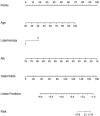Development and validation of a nomogram to predict the risk factors of major complications after radical rectal cancer surgery
- PMID: 38577342
- PMCID: PMC10991776
- DOI: 10.3389/fonc.2024.1380535
Development and validation of a nomogram to predict the risk factors of major complications after radical rectal cancer surgery
Abstract
Purpose: The aim of this study was to establish a validated nomogram to predict risk factors for major post-operative complications in patients with rectal cancer (RC) by analyzing the factors contributing to major post-operative complications in RC patients.
Methods: We retrospectively collected baseline and surgical information on patients who underwent RC surgery between December 2012 and December 2022 at a single-center teaching hospital. The entire cohort was randomly divided into two subsets (60% of the data for development, 40% for validation). Independent risk factors for major post-operative complications were identified using multivariate logistic regression analyses, and predictive models were developed. Area under the curve (AUC) was calculated using receiver operating characteristic curve (ROC) to assess predictive probability, calibration curves were plotted to compare the predicted probability of the nomogram with the actual probability, and the clinical efficacy of the nomogram was assessed using decision curve analysis (DCA).
Results: Our study included 3151 patients who underwent radical surgery for RC, including 1892 in the development set and 1259 in the validation set. Forty (2.1%) patients in the development set and 26 (2.1%) patients in the validation set experienced major post-operative complications. Through multivariate logistic regression analysis, age (p<0.01, OR=1.044, 95% CI=1.016-1.074), pre-operative albumin (p<0.01, OR=0.913, 95% CI=0.866-0.964), and open surgery (p<0.01, OR=2.461, 95% CI=1.284-4.761) were identified as independent risk factors for major post-operative complications in RC, and a nomogram prediction model was established. The AUC of the ROC plot for the development set was 0.7161 (95% Cl=0.6397-0.7924), and the AUC of the ROC plot for the validation set was 0.7191 (95% CI=0.6182-0.8199). The predicted probabilities in the calibration curves were highly consistent with the actual probabilities, which indicated that the prediction model had good predictive ability. The DCA also confirmed the good clinical performance of the nomogram.
Conclusion: In this study, a validated nomogram containing three predictors was created to identify risk factors for major complications after radical RC surgery. Due to its accuracy and convenience, it could contribute to personalized management of patients in the perioperative period.
Keywords: complications; nomogram; rectal cancer; risk factors; surgery.
Copyright © 2024 Lv, Yuan, Qu, Diao, Hai, Xiang and Peng.
Conflict of interest statement
The authors declare that the research was conducted in the absence of any commercial or financial relationships that could be construed as a potential conflict of interest.
Figures




Similar articles
-
Phase angle is a predictor for postoperative complications in colorectal cancer.Front Nutr. 2024 Aug 16;11:1446660. doi: 10.3389/fnut.2024.1446660. eCollection 2024. Front Nutr. 2024. PMID: 39221167 Free PMC article.
-
The risk factors and predictive nomogram of human albumin infusion during the perioperative period of posterior lumbar interbody fusion: a study based on 2015-2020 data from a local hospital.J Orthop Surg Res. 2021 Oct 30;16(1):654. doi: 10.1186/s13018-021-02808-5. J Orthop Surg Res. 2021. PMID: 34717707 Free PMC article.
-
[Risk factor analysis on anastomotic leakage after laparoscopic surgery in rectal cancer patient with neoadjuvant therapy and establishment of a nomogram prediction model].Zhonghua Wei Chang Wai Ke Za Zhi. 2019 Aug 25;22(8):748-754. doi: 10.3760/cma.j.issn.1671-0274.2019.08.009. Zhonghua Wei Chang Wai Ke Za Zhi. 2019. PMID: 31422613 Chinese.
-
Development and Validation of a Risk-Prediction Nomogram for Preoperative Blood Type and Antibody Testing in Spinal Fusion Surgery.Orthop Surg. 2024 Jan;16(1):111-122. doi: 10.1111/os.13946. Epub 2023 Dec 3. Orthop Surg. 2024. PMID: 38044447 Free PMC article.
-
Construction of a nomogram model for predicting the outcome of debulking surgery for ovarian cancer on the basis of clinical indicators.Front Oncol. 2024 Jul 10;14:1421247. doi: 10.3389/fonc.2024.1421247. eCollection 2024. Front Oncol. 2024. PMID: 39050577 Free PMC article. Review.
Cited by
-
Evaluation of anastomotic blood supply during digestive tract reconstruction with the use of the oxygen saturation index: A pooling up analysis.Int J Colorectal Dis. 2025 Mar 18;40(1):71. doi: 10.1007/s00384-025-04864-3. Int J Colorectal Dis. 2025. PMID: 40102303 Free PMC article.
References
-
- van der Pas MH, Haglind E, Cuesta MA, Fürst A, Lacy AM, Hop WC, et al. . COlorectal cancer Laparoscopic or Open Resection II (COLOR II) Study Group. Laparoscopic versus open surgery for rectal cancer (COLOR II): short-term outcomes of a randomised, phase 3 trial. Lancet Oncol. (2013) 14:210–8. doi: 10.1016/S1470-2045(13)70016-0 - DOI - PubMed
-
- McSorley ST, Horgan PG, McMillan DC. The impact of the type and severity of postoperative complications on long-term outcomes following surgery for colorectal cancer: A systematic review and meta-analysis. Crit Rev Oncol Hematol. (2016) 97:168–77. doi: 10.1016/j.critrevonc.2015.08.013 - DOI - PubMed
LinkOut - more resources
Full Text Sources

